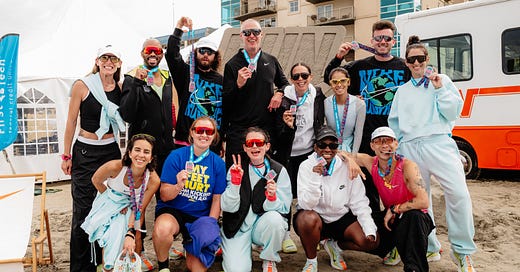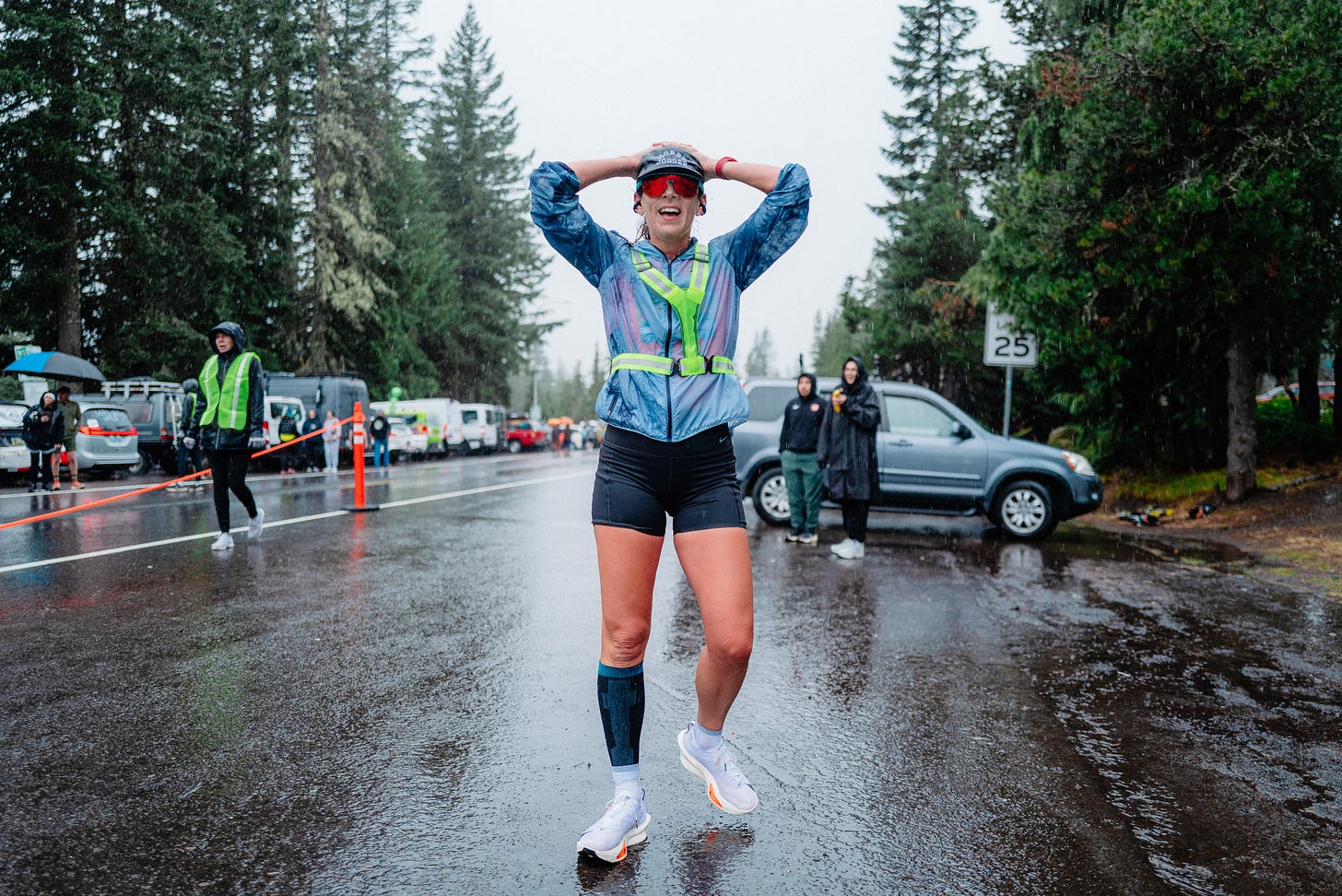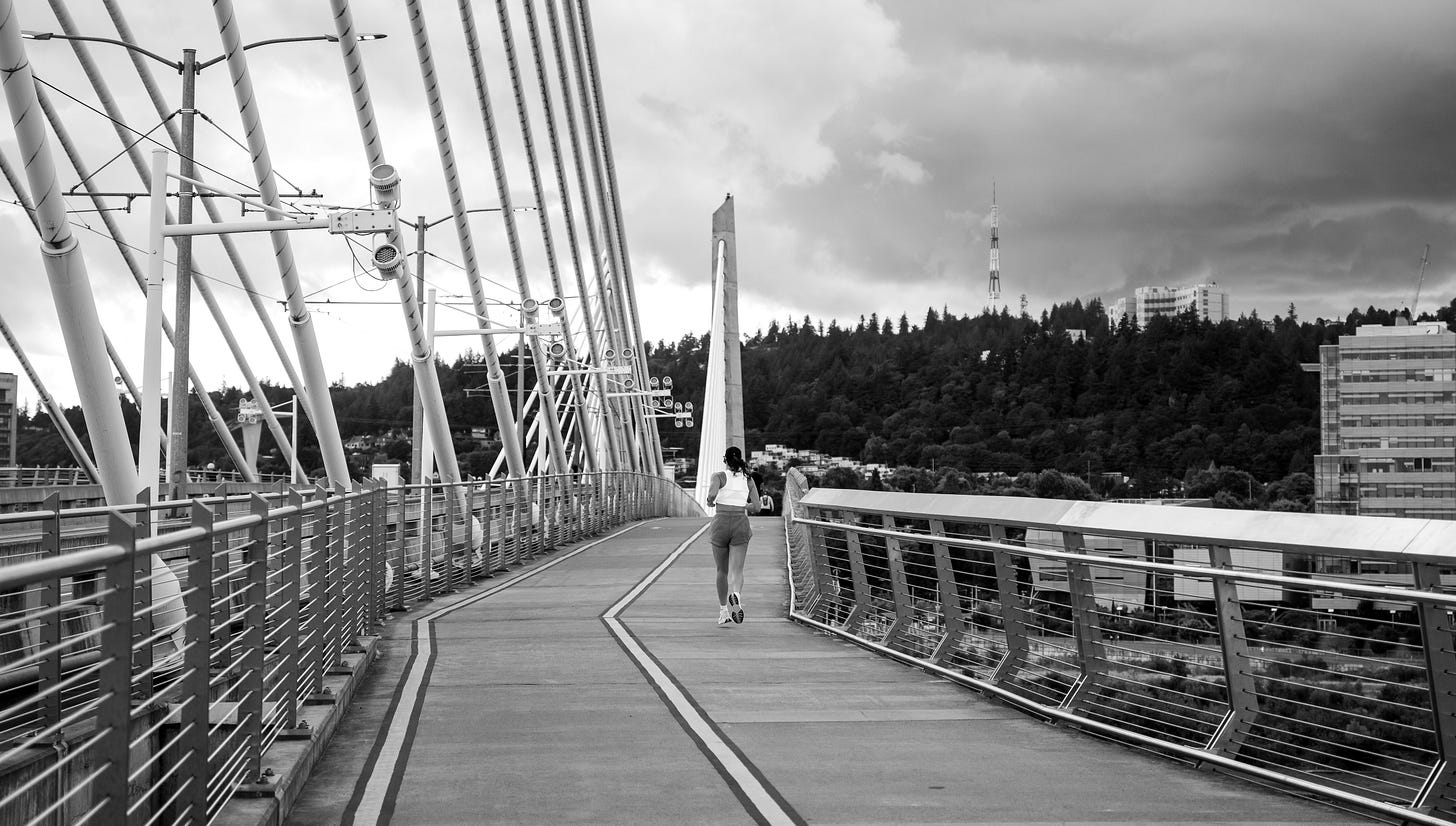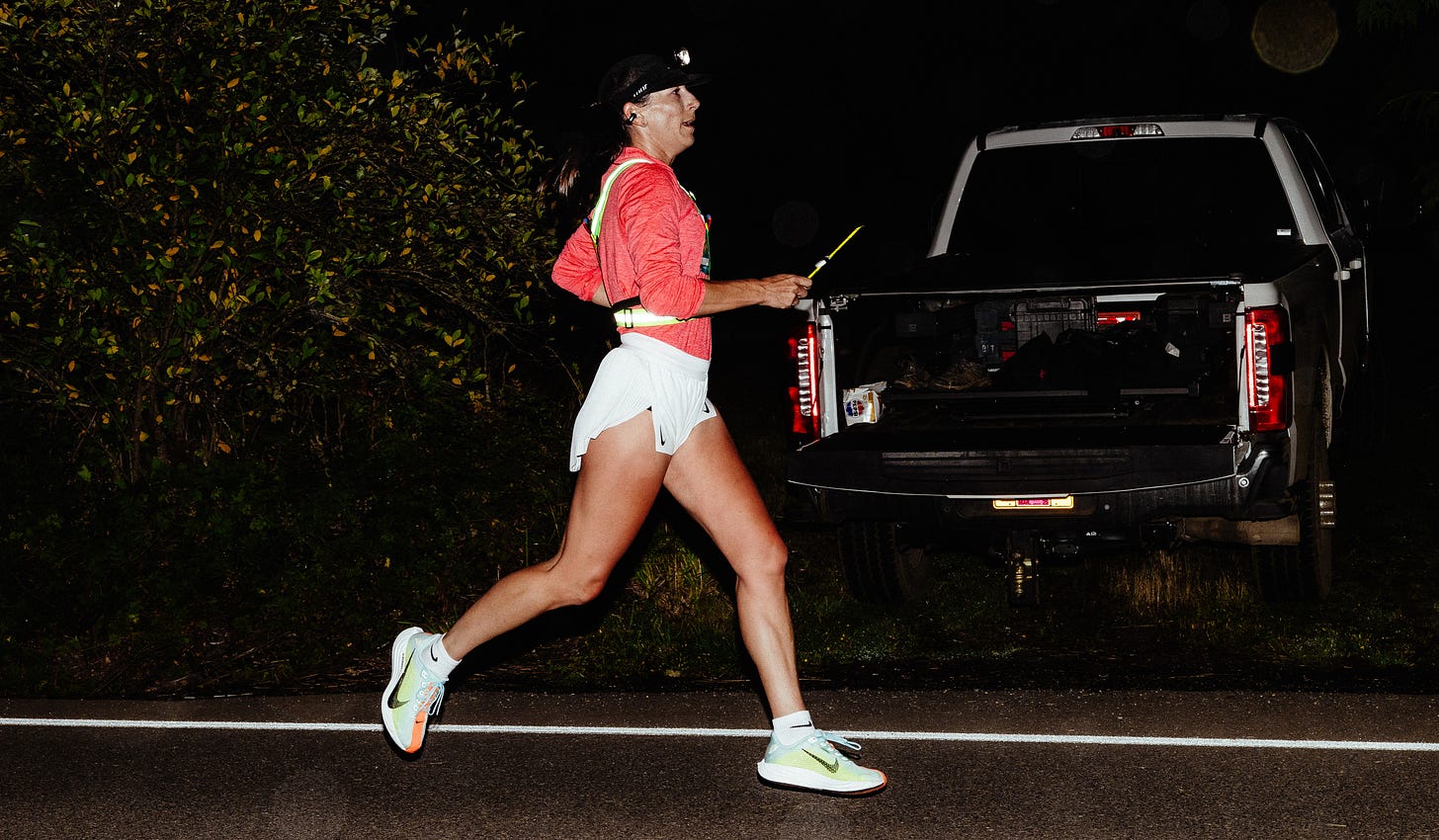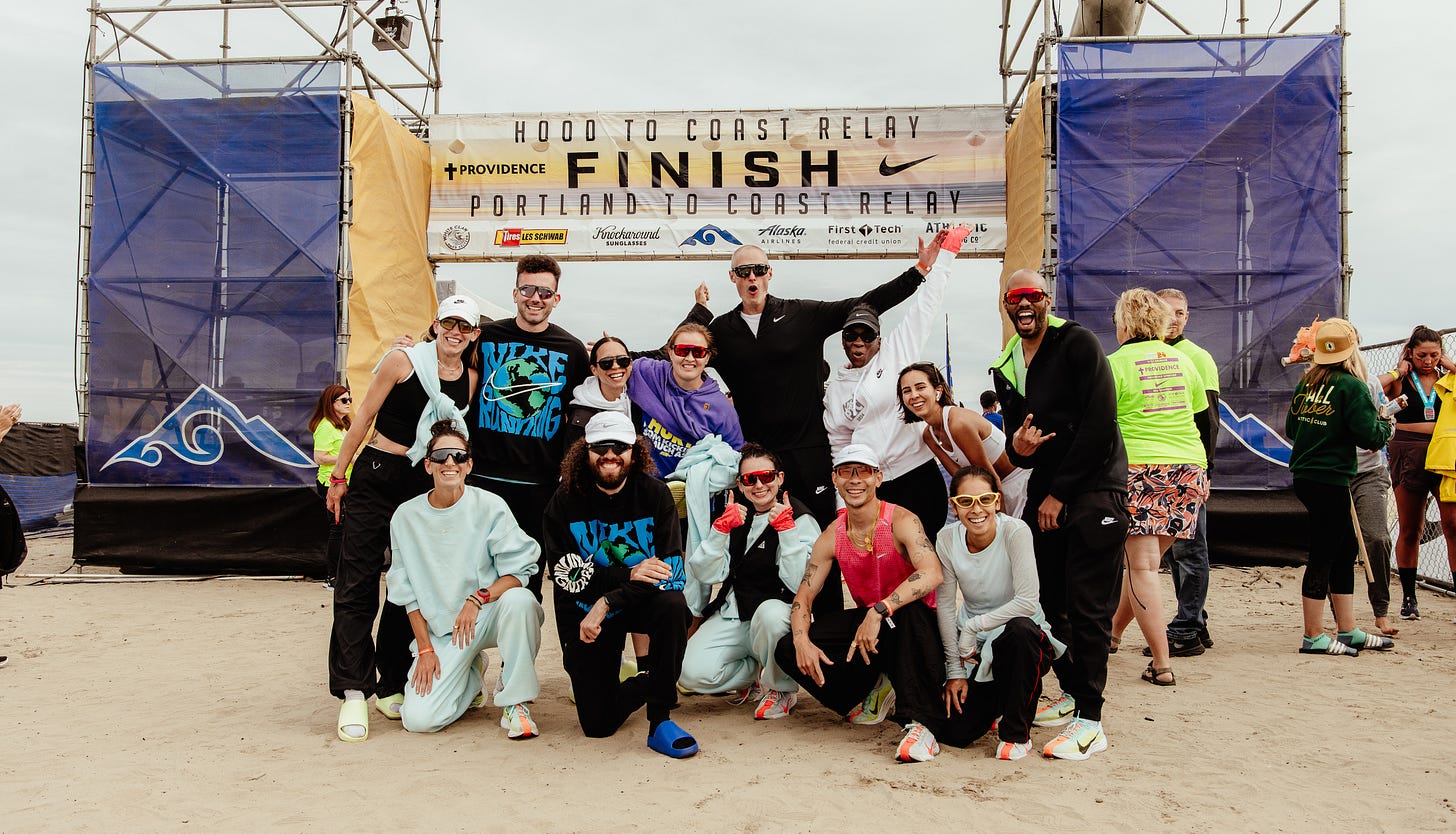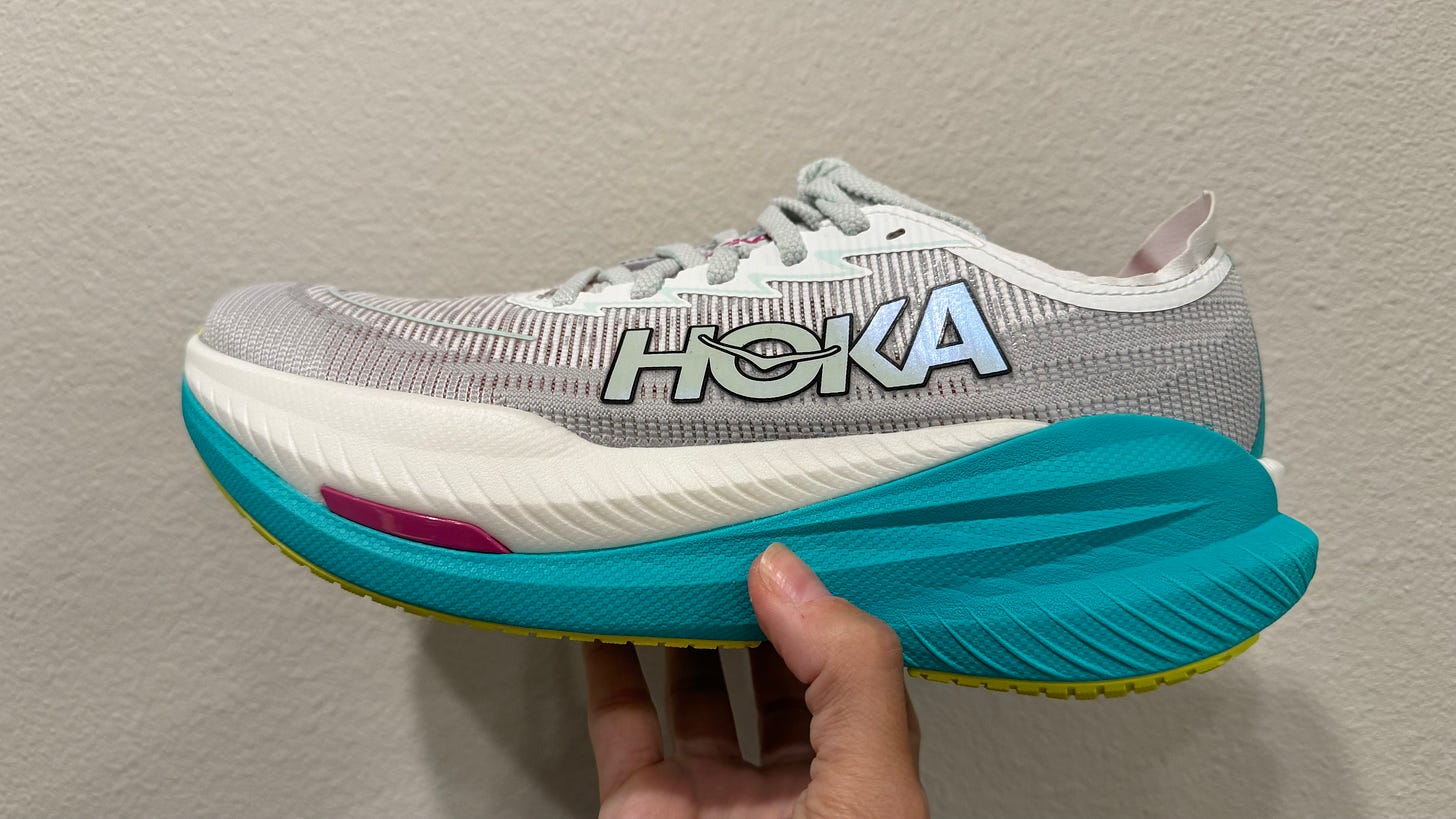Hood to Coast Relay Recap
Nearly 200 miles. 12 runners. 2 vans. Just under 26.5 hours of organized chaos.
I’ve never been interested in running super long distances solo. But 200 miles split between friends? Well, that sounds like a blast.
The Hood to Coast Relay is the largest relay race in the world—it’s known as “the Mother of All Relays”—with over 1,000 teams of eight and 12 runners covering the 196 miles from the top of Mount Hood to the Oregon coast. (There’s also a 128-mile walking option called Portland to Coast). This race has sold out on lottery opening day for 31 consecutive years, which makes it sound as hard to get into as the New York City Marathon. When Nike invited me to join a team of journalists, content creators, and influencers, it was an immediate yes—I think I responded to the email within 15 minutes.
Here’s how it works: We had a team of 12 runners split between two vans (each van had a driver, plus Coach Jes Woods from Nike and photographer Nick Carnera—the real MVPs—who went back and forth between the two). Each runner was responsible for three separate legs along the course, and the distances varied between three and eight miles. Van 1 kicked things off, and after each van 1 runner completed their first leg, the sixth runner passed the metaphorical baton to van 2; we did that three times. While one van runs, the other van rests (as well as they can with seven people crammed in a sprinter van).
These were my legs:
I’ve run two Ragnar races—a point-to-point relay from Chattanooga to Nashville in Tennessee, and a trail relay based in Snowmass, Colorado, where you camp in one spot and run loops—so I knew what I was getting into. But it’s hard to predict how a group of good friends will handle the logistical and physical stressors of an event like this, let alone how a team of 12 that kinda/sorta knows each other will fare. But everyone on Team Peg Legs (we were running in Nike’s new Pegasus Plus, get it?) was stoked to be there, and ready to send it in whatever way felt best to them. The vibes were high, which is the best way to start something crazy like this.
Leg #1: Take Me Down
Of course I volunteered for Leg #1. Not only does this leg kick off the entire race at the top of Mount Hood, it’s described as a “severe downhill”—my favorite kind of route. While I was very prepared for the 1,885 feet of descent down Timberline Road (thank you, Slacker), I was a little less prepared for the 38°F temperature and driving rain. But this is the kind of route where you just have to send it and hold on for dear life no matter the conditions, and that’s exactly what I did. (I opted to wear the Alphaflys on this section to better protect my lower legs from some of the pounding; it…sort of helped?)
Timberline Road winds through the Pacific Northwest forest down the mountain, and I’m sure there are beautiful views on nice days but I was mostly treated to fog and rain. That made it easier to just focus on the pace and taking bodies (part of the fun of these relays is tracking how many runners you pass). I was shooting for 5K pace for at least 5K of my 5.6 miles—I wanted redemption for some of my recent shorter races. Mile one was supposed to be a warm-up, but after effortlessly holding just above my goal pace for a little under a mile, I decided to let it rip (losing 433 feet in one mile certainly helped). Not only did I lower my 5K PR by 20 seconds, I held on to that pace for the entire 5.6 miles and was kicking into an even higher gear when I reached Government Camp to hand off the baton to our next runner. The best part? Even though my back was tight, this cramp that’s been plaguing me never migrated around to my abs and I was able to breathe easily even at my fastest paces. Finally, a race day win!
Leg #2: Just Keep Running
Normally, once you kick off a relay like this, you’re either running or in the van all the way until the finish. But because Hood to Coast runs through downtown Portland, our team was actually able to go back to our hotel for a shower (thank god, because I was soaked through from the rain) and lunch. We had about two hours before we headed to The Oregon Museum of Science and Industry to pick up the baton from Van 2.
This route immediately took me over Tilikum Crossing, a cable-stayed bridge across the Willamette River (it reminded me of the Boston skyline). Then I dropped back down and spent the next four-ish miles running along the Willamette River, passing by Old Town, the Pearl District, and Slabtown. Of course it rained again. Overall, the course was well-marked but I almost accidentally got lost at one point; thankfully, I remembered the map warned of a “uneven ground” and made the turn on to a gravel section before getting back on the main riverside path. My legs were definitely heavy on this section, but I was surprised by how easy holding just above marathon pace still felt (and still no cramp!). I didn’t get passed by a single runner, and passed even more than I did on the first leg.
Leg #3: In the Middle of the Night
Even though this was my shortest leg (just 3.8 miles), I knew it was going to be the hardest one because a) I’d be running it around 1 a.m. and b) it was my hilliest leg, with around 100 feet of elevation gain. (I know that’s not a lot, but it felt like a lot to me after running 2,000 feet downhill in less than six miles!) We were also in the middle of nowhere—Birkenfeld, OR—with no cell coverage, so it was a total guess as to when Van 2 would be coming in for the baton exchange. I managed to get two hours of not at all restful sleep while spread across the middle seat of the van until we were woken up by someone else’s team on the walkie talkie—and good thing, because Van 2 was ahead of schedule. I threw on my clothes and safety gear (reflective vest, blinking lights, and a headlamp), and headed out into the mist to grab the baton.
Despite feeling totally discombobulated for the first few minutes, I actually ended up really enjoying this section, which covered gently rolling hills on paved country roads. Running in the dark is physiologically harder, but the lack of almost any external stimuli (few cars, no lights, and barely any noise) kept me super present and focused on the mile I was in. Because it was pitch black out, I couldn’t really see the incline in front of me at all which helped me hold my pace without telling myself I needed to slow down or walk (my legs were basically dead weight). I did start getting passed by faster runners at this point; faster teams start later in the day, but by this point they had clearly made up some serious ground. I wasn’t even thinking about pace on this leg, my only focus was reeling in any runners in front of me and getting back to my crew.
The Grand Finale
Since I was in van 1, we finished in the early hours of the morning and made it to the Pacific Ocean before 8 a.m.—all we had to do was rest (and eat) until van 2 made their way to us so we could all cross the finish line together. The post-race massage on the beach? Probably one of the best decisions I’ve made in my life. Just before 11 a.m., we got the alert that our final runner was in their last mile. The goal was to run it in as a team, but what ensued was total chaos and hilarity as she sprinted past us for a final time of 26:28:57. We managed to finish 150th out of 1180 teams—top 10 percent!
But it was never about the time. We had runners of all levels on our team, and there was no real goal going into this other than to survive and, ideally, thrive. A relay like Hood to Coast really embodies the idea that while running itself is a solitary endeavor, it can be a team sport. Getting to that finish line was a group effort. Some of us knew each other at the start, some of us did not; either way, we all came together to go the distance. We shed soaked clothes without any HR violations, shared a single pair of sweaty compression boots, came up with creative sleeping situations, cleared out our sinuses with the pervasive odor of Icy/Hot, powered through an ungodly amount of Cheribundi packets and Uncrustables, located lost headphones in the last minutes before a leg, and nailed our handoffs between each leg.
Yes, Hood to Coast is a bucket list running experience. It’s an incredible opportunity to push your limits while running through both the beautiful locations and the more challenging ones. But it’s also a reminder of how special the running community can be when we come together instead of competing against each other. We had runners of all levels on our team, and there was no comparison, no pressure; we were each other’s biggest cheerleaders, whether someone was covering a new-to-them distance or chasing a personal best, or dealing with anxiety around an injury or the fear of running alone at night. When running becomes less about your personal goals (not that there’s anything wrong with having those!) and more about how you can push yourself while also lifting up those around you, it makes for a better experience—and a better community—overall.
the rundown
Hoka Mach X 2
There’s nothing worse than when a brand releases a great new shoe, then follows it up the next year with a “revamp” that messes with what you loved. That’s not the case with the Hoka Mach X 2. The original Mach X had a dual-density midsole, combining a lighter, softer PEBA-based foam with a more traditional EVA foam; this time, there’s even more PEBA and the winged plate is more like what you’d find in the Cielo X1. Hoka ditched the creel jacquard upper from the first iteration, and I’m glad for it. That softer, thicker upper trapped heat on warmer runs, but this version’s lightweight, woven mesh is more similar to a race shoe construction—which does make it a little harder to get on, but that wasn’t a dealbreaker (it seems some reviewers had issue with rubbing at the heel, but I didn’t experience that).
How the “Everyone Watches Women’s Sports” T-Shirt Went Viral
You couldn’t miss the “Everyone Watches Women’s Sports” t-shirt during the Olympics, and I’m kicking myself for not pitching this story—I bought it back in May! Harper’s Bazaar covered how Togethxr’s slogan tee went viral. Togethxr was created in 2021 by a group of female pro athletes, including WNBA legend Sue Bird, soccer star Alex Morgan, swimmer Simone Manuel, and snowboarder Chloe Kim, and the shirt was released back in December. Obviously, women’s sports are having more than a moment (I talked about this related to the Olympics), but it took until this summer for it to become a statement piece. You can buy it here.
Sleep Hygiene, Light Exposure Improve Performance After Long-Haul Air Travel
If you’re running an international race this fall, pay attention: Sleep hygiene and light exposure can improve performance after long-haul air travel, according to a 2020 study published in the International Journal of Sports Physiology and Performance. For 72 hours post-flight, researchers had athletes focus on regular sleep schedules, minimizing screen time before bed, and controlling light exposure (morning bright light and evening dim light). Those athletes showed significant improvements in cognitive performance, faster reaction times, and reduced fatigue compared to athletes who didn’t do those things. Make sure to give yourself enough travel time to implement these measures pre-race so you don’t blow up in the final 10K from jet lag, like I did at the Tokyo Marathon.
Shoe Brands Are Leading the Charge in Hiring Female Chief Marketing Officers
Women own more shoes and spend more on shoes than men, but the role of chief marketing officer—which has the goal of increasing sales and brand recognition—has historically been held mostly by men. Recently, however, there’s been a shift, reports Footwear News: 55 percent of CMO appointments in the footwear industry so far this year have been women, an eight percent increase over last year’s hires. Brands including Kizik, Journeys, Saucony, and DSW have hired female CMOs in 2024; Allbirds, Schuh, Nike, Manolo Blahnik, and Timberland already have female CMOs. Interestingly, close to 70 percent were externally hired from other industries, which means they’re bringing fresh eyes to the shoe industry—a move that will hopefully benefit consumers of all genders.


